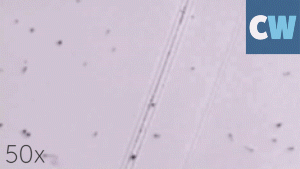Nanotechnology – Page 7
-
 Research
ResearchGraphene sponge soaks up good vibrations
Material could enhance artificial skin with tactile sensors
-

-
 Research
ResearchNano repair bots mimic wound healing to seal cracks
Janus particles swim to site of damaged electrical circuit and get it working again
-
 Research
ResearchSpeedy DNA nanomachines are on a roll
First DNA-based roller is 1000 times faster than current DNA motors
-
 Research
ResearchStencilling self-propulsion engines
New method prints tiny artificial fish that could find use in water remediation
-
 Research
ResearchRolled-up electrodes record brain activity without scarring
Super-flexible polymer offers way to monitor neural signals over the long-term for chronic conditions such as Parkinson’s disease
-
 Research
ResearchCarbon nanotube rectenna directly converts light into electricity
The nanotube array confirms a 40-year old theory and may offer a new way of constructing solar cells
-
 Research
ResearchTrapped nanoparticles could bring 'wet' computing a step closer
Information can be rapidly stored and retrieved from single colloidal particles using light and electricity
-
 Research
ResearchMolecular Sierpinski triangles get stability upgrade
Another research team have fun with fractals
-
 Research
ResearchKirigami graphene makes microscale devices
Ancient Japanese folding and cutting art form used to create functional springs and hinges
-
 Research
ResearchRepellent nanocraters could shape tissue engineering
Nanoscale holes can be used to shepherd cells with applications in stem cell and medical implant technologies
-
 Research
ResearchSuper-elastic wire stretches without losing power
Fibre that can stretch 14 times its own length could find its way into robotic arms and satellites
-
 Research
ResearchCarbon nanotube-based sensor detects meat spoilage
Electron density of cobalt porphyrin complexes key to meat freshness sensor
-
 Research
Research'Safe antifreeze' works better with added nanoparticles
Antifreezes based on a non-toxic food additive are now more effective and user-friendly
-
 Research
ResearchSilicene 'sandwich' transistor a delectable prospect
Researchers have made a transistor from one-atom-thick silicene for the first time
-
 Research
ResearchLEDs slim down with atom thick materials
UK and Japanese scientists create ultrathin, semi-transparent and flexible LEDs
-
 Research
ResearchDNA origami makes moving machines
Hinge-like structures can open and close again and again on binding of DNA
-
 Research
ResearchSmart nanoparticles take aim at cancer cells
Intranuclear radiosensitisation technique intensifies radiotherapy to drive tumour regression in mouse model
-
